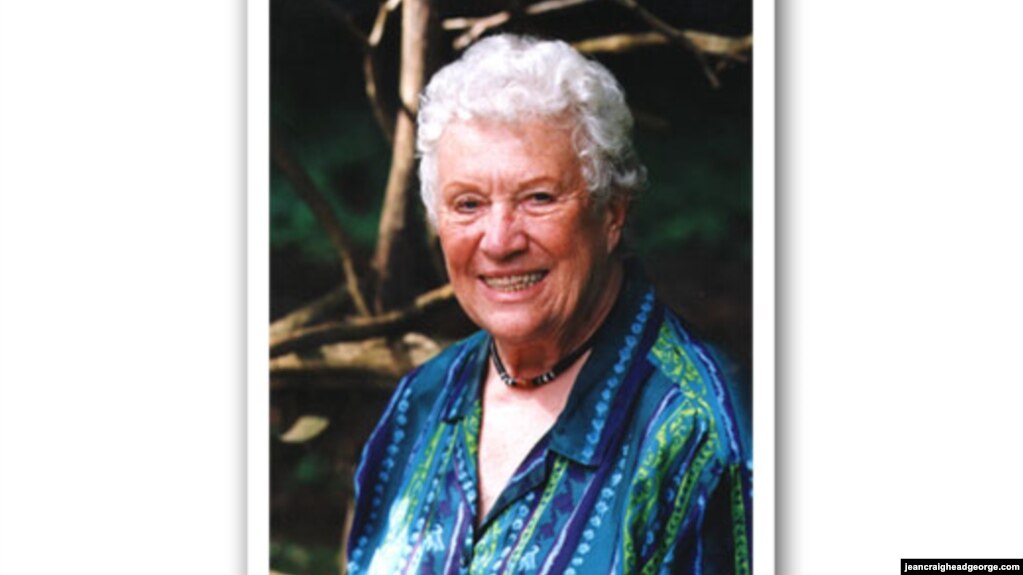
JUNE SIMMS: Welcome to AMERICAN MOSAIC in VOA Special English. I’m June Simms.
This week on our program, we remember the much-loved children’s writer Jean Craighead George…
We also tell about a popular horse race in Virginia…
And we play new music by Beach House…
(MUSIC)
Jean Craighead George
JUNE SIMMS: A well-loved children’s book writer has died. Jean Craighead George wrote many books, including “Julie of the Wolves” and “My Side of the Mountain.” Her stories often tell about the beauty and power of wilderness, and the young people trying to survive in it. Christopher Cruise has more.
CHRISTOPHER CRUISE: Jean Craighead George died on May fifteenth following a stroke. The writer had lived ninety-two years, much of that exploring the wilderness and its animals. She also spent a lot of time writing, producing more than one hundred books.
Jean Craighead George was born in Washington, DC, in nineteen-nineteen. Her interest in nature and animals came early and maybe from her father. He worked for the National Forest Service. The family spent a lot of time in wooded areas along the Potomac River. Jean and her twin brothers learned how to build shelters and find food in the woods.
Her brothers trained falcons, one of the most powerful birds in the DC area. Jean Craighead George said the twins were among the first falconers in the United States. She also said that they gave her a falcon to train when she was thirteen years old. Later the main character in one of her books develops a close relationship with a falcon.
Jean Craighead George studied science and English at Pennsylvania State University. She worked as a reporter during the nineteen forties. She also married and had three children during this period.
She and her family started exploring wilderness areas all over the country. They also raised many animals, from huge tarantula spiders to owls and minks. And, of course, more traditional pets like dogs and cats.
The family had more than one hundred seventy animals, although not all at once. Jean Craighead George said the pets were always free to stay or go.
Her career in children’s literature began in nineteen forty-eight with the publication of her first book, “Vulpes the Red Fox.” Eleven years later came “My Side of the Mountain,” one of the best loved children’s books ever.
It tells the story of Sam Gribley, a boy who escapes the busy life of New York City. He goes to live in the wilderness of the Catskill Mountains. His home is a hollowed out tree.
Sam makes friends with several animals, including a falcon he calls Frightful. He hunts and fishes and finds plants to eat. He also steals deer that have been killed by hunters.
Jean Craighead George said she wrote “My Side of the Mountain” to tell about all the wonderful adventures she experienced as a child in the woods. The American Library Association recognized the book with a Newberry Honor in nineteen sixty.
In nineteen seventy-three, Jean Craighead George won a Newberry Medal for “Julie of the Wolves.” She had earlier travelled to Barrow, Alaska and met with scientists there. They taught her how to communicate with wolves. The author said she was finally successful with a beautiful female wolf. She knew then she wanted to write about a little Eskimo girl lost on the frozen land. Julie survives by learning how to talk to the wolves. They then help protect her.
Jean Craighead George’s website includes a short video of the author talking to her dog. It is not a wolf like the one Julie ran with, but a close relative -- the Alaskan malamute.
(VIDEO)
Jean Craighead George hoped her work in fiction would help children enjoy the wilderness and also protect it. Her own children followed in her footsteps. Her daughter writes books about nature for children. One son is a whale researcher. The other studies birds.
Jean Craighead George died at a hospital in New York state, where she lived most of her adult life.
(MUSIC)
The Virginia Gold Cup
JUNE SIMMS: Horse racing is one of the oldest sporting events in the world. And it can be a major economic support in some places. But, horse racing requires a lot of space, for the activity itself and for the large crowds who like to watch. As development spreads further and further from cities, horse racing is threatened.
But in Virginia, one horse race is still going strong after nearly ninety years. About fifty thousand people attend the Gold Cup each year in the rolling hills of The Plains, Virginia.
Many in the crowd wear fine clothes, including creative hats covered with flowers, feathers or other decorations. And those hats are judged. A hat competition is part of the Gold Cup tradition.
The event also always includes food and drink. Some people just bring containers of sandwiches and sodas. Others have full size tents with grills and professional cooks. Race visitor Thomas Eden grew up in the area.
THOMAS EDEN: “It’s the one day in the year that everyone drops everything and decides to be nice for a day and dress up a bit. And I love dressing up…it’s my thing.”
The Gold Cup is a steeplechase event. The horses race across fields and jump over fences. George Webb has been attending the Gold Cup for twenty years.
GEORGE WEBB: “People love getting out in the country. It’s such a beautiful area. It is a part of history. George Washington hunted fox in this very area out here. This remains something very near and dear to folks out here.”
The area used in a steeplechase is much larger than a traditional horse race track. Several steeplechase events have been forced to move in recent years, as more land is developed. The Gold Cup moved to its current space in nineteen eighty-five.
And, real estate developers continue to move toward the fields where the race takes place. But George Webb, a developer himself, is not worried. He says the organization that runs the Gold Cup is working, so race fans can enjoy the event now and in the future.
(MUSIC)
Beach House “Bloom”
JUNE SIMMS: The two member group Beach House just released their fourth record album, eight years after the first. The Los Angeles Times newspaper says the new album, “Bloom,” is a “lovely lullaby.” American Songwriter calls “Bloom” either “beautifully sad or sadly beautiful.” And Rolling Stone gave it four and one half stars out of a possible five.
Faith Lapidus plays some of the new album.
(MUSIC)
FAITH LAPIDUS: That song is called “Myth.” It is the first song on “Bloom.” And it was one of only two singles released before the album.

Victoria LeGrand sings and writes Beach House songs. She told a reporter that she and Alex Scally thought “Myth” would be a great gateway into the album. The song starts with the words: Drifting in and out / See the road you’re on / You came rolling down the cheek / You say just what you need
“Troublemaker” has a similar simple poetry. Victoria LeGrand sings, like a hand you reached out to me / the thunder rolls in with the dark / tiny fingers on the edges / watch it unravel pulling everything apart
(MUSIC)
Beach House travelled to a recording studio in Tornillo, Texas. The rural beauty of the southwestern town seems to have lent a quiet dreaminess to the album. Victoria LeGrand says the album itself is a journey. “A bloom is only temporary” she says, “a fleeting vision of life in all its intensity and color.”
We leave you with Beach House performing “On the Sea” from the group’s new album “Bloom.”
(MUSIC)
JUNE SIMMS: I’m June Simms. This program was written and produced by Caty Weaver. Tala Hadavi provided additional reporting.
Join us again next week for music and more on AMERICAN MOSAIC in VOA Special English.



